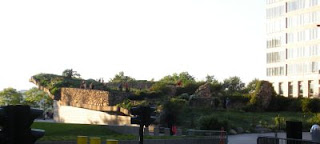In the present day, the area around Ground Zero has become a big tourist destination, which produces some strange juxtapositions. Double-decker tour buses went by on Broadway almost every minute. In front of historic Trinity Church, tables were set up selling flea-market stuff -- knock-off bags and watches, cell-phone cases, cheap souvenirs.
Back to the past ... Alexander Hamilton is buried in the Trinity Church graveyard:
Near the end of Broadway is Bowling Green Park. The fence that surrounds it is the original fence built in 1771, which makes it one of the oldest man-made structures in Manhattan:
After the tour, I walked around the neighborhood on my own. I got a bit lost, but eventually ended up on an overpass that looked out on the World Trade Center site. At this stage, it looked just like any ordinary construction site.
After walking along the overpass, and still on that same level, I ended up in a maze of buildings, eventually finding myself at the top of a marble staircase in what I later found out was the World Financial Center. Below was a huge glass-enclosed atrium filled with palm trees, which didn't seem like they belonged in New York!
Outside in the back, there were a whole bunch of tables overlooking a harbor. It was beautiful, and for once, the weather was perfect. I sat and relaxed, and finished reading a New Yorker story about Agatha Christie.
The setting, between the huge glass-domed atrium and the waterfront promenade, reminded me of a walk I had taken with my father about 25 years ago, on another segment of this promenade, and through another huge high-domed building (which I'm pretty sure was destroyed on 9/11). My father had been fascinated with the area, which at that time had a lot of new construction going on -- the twin towers themselves were relatively new -- with its maze of passageways hanging overhead in the air. (Editing to add: I just read that the Battery Park City area was built on landfill made from materials excavated when the Twin Towers were built. So at the time of the walk with my father, that whole area must have been brand new -- and thus my father's interest.)
I went back out through the front of the building, and this time I knew where I was. I went to take a closer look at a structure near the water, which I had seen in passing a couple of months ago. It looks like a park that is hanging in the air.
There were people walking on paths that wound through the greenery, but there was no immediately obvious way to get up there. I started walking around the structure. On the right side, there were long strips on the wall below the park. The strips appeared blank, but as I walked past, words from quotations suddenly became visible, as if by magic.
The entrance was all the way in the back, on the side facing the river. It was a sleek tunnel which gave no hint of the lush greenery soon to be encountered.
I had no idea what this place was until I got home and looked it up on the computer. It's the Irish Hunger Memorial (photos, more photos, New Yorker, NY Times).











Wow. What an amazing post. The Irish Memorial is so striking. And the palm trees inside remind me of The Met, when you can see New York outside the big glass windows and next to you is a pyramid. It's fantastically disorienting.
ReplyDeleteI love that people walk past that iron fence every day, having no idea it was built in 1771. Now that's craftsmanship.
They don't make fences like they used to! ;-)
ReplyDeleteGood observations -- thanks.